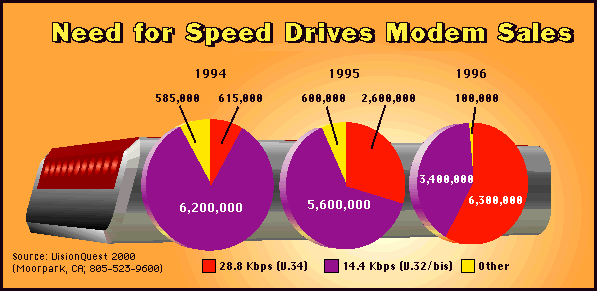
Phone Lines Stymie V.34 Modems
By Steven J. Vaughan-Nichols
BYTE
November 1995
Today's advanced modems push the telephone system to the limit, and users are finding to their woe that in many cases, 28.8-Kbps modems won't deliver their advertised throughput. The result: That blazingly fast 28.8 V.34 modem you bought won't deliver better than 26.8 Kbps except under prime conditions. In fact, performance could be much worse.
Even the newest modems with the amended V.34 standard, which allows for speeds up to 33,600 bits per second, won't solve your speed problem. These advanced V.34 modems, from companies such as U.S. Robotics, AT&T Paradyne, and Racal-Datacom, still have to contend with a telephone system that was never meant to handle such high-speed data communications.
Stephen Satchell, president of Satchell Evaluations (Incline Village, NV), an independent modem-testing firm, says the trouble usually isn't the quality of the copper in the phone system's local loops. He says the problems are due to trunk components and switches. "Their soakers, designed to cut down on static, artificially limit the bandwidth that V.34 needs to operate effectively," Satchell says. "Interoffice phone systems also often have artificially narrow channels that introduce distortion in the data channel." This means that even the best V.34 modem talking to the same brand of modem will often top out at 26,600 bps.
Another growing problem, Satchell says, is that the phone companies, in their changeover from analog to digital circuits, are using digital speech compression to get the most voice service from existing lines. That's fine for voice, but it's a disaster for modem users because it closes your effective bandwidth window down to a maximum of 9600 bps. "Entire neighborhoods are being changed over," Satchell says. "Modem users don't have a way out." Indeed, for many of us, the first thing you'll know about the arrival of digital voice compression on your block is when your data communication slows to a fat baby's crawl.
Many other factors determine how fast your modem can pump out data. Some of these, like the UART (universal asynchronous receiver/transmitter) chip, are under your control. But other vital elements are outside your control. For example, early-model U.S. Robotics Sportster modems -- those with ROMs older than April 18, 1995 -- suffer from the spiraling death syndrome. The modem will blithely try to optimize the V.34 connection, but it ends up corrupting the connection so that speeds drop slowly but surely to a horrific 4800 bps. If you think you're running into this problem, you can check your ROM with the modem command ATI7. If you have one of the older ROMs, U.S. Robotics will replace it for free; call them at (703) 982-5151.
A far more common and annoying problem, since it has no solution, is that modems built around the Rockwell chip set do not show consistent speed results, even under laboratory conditions. Satchell says he's seen results ranging from 21,600 bps to 28,800 bps using Rockwell-based modems from such popular vendors as Cardinal, Global Village, Hayes, Supra, and Practical Peripherals, with absolutely no change in the testbed configuration.
A better way to get a consistently fast data connection is through ISDN. The problem with ISDN, which can push your data connection up to 128,000 bps, is twofold. First, you can't get ISDN services everywhere. Some Baby Bells, such as Bell Atlantic, are very ISDN-friendly; others, such as Nynex, are not. The second problem is that local regulators are very inconsistent in their treatment of ISDN. In some states, ISDN is so heavily taxed that it is utterly impractical for private use. In other states, ISDN may be no more expensive than an ordinary additional phone line.
If you can't get ISDN, you may want to investigate a telephone line conditioner. NAI Datacomm (Roswel l, GA, 800 778-4479 or http://naidata.com on the Web) has its VFast Modem family of superchargers (about $600 or less), which can optimize modem performance. However, as company officials point out, these products address only problems at the local loop.
For now, we're stuck with less-than-perfect analog modems in an environment that will grow increasingly more hostile to high-speed performance. This should not prevent buyers from flocking to V.34 modems, however (see the graph). "Some users, especially when accessing the Internet, will take any speed improvement they can get," says Ernie Raper, market analyst for VisionQuest 2000 Associates (Moorpark, CA). "Even if the V.34 modem delivers 26 Kbps or 24 Kbps, that's a lot more data being transmitted than 14.4 Kbps." Raper predicts that prices for V.34 modems will drop steadily, which will result in a minor price difference between 14.4- and 28.8-Kbps modems.
In the long term, ISDN, clearly the optimal technical solution, will be the future of end-user data communications. For the next few years, though, take all claims of modem speed with a dose of salt.
Need for Speed Drives Modem Sales

The need for speed to access the Internet or a private remote network will fuel U.S. aftermarket retail sales of 28.8-Kbps V.34 modems, despite the inconsistency of data throughput.
Copyright © 1995 CMP Media LLC